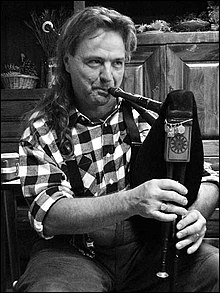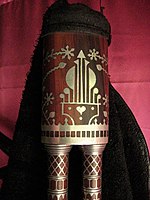Cornemuse du Center
The Cornemuse du Center is a type of bagpipe that is widespread in France . According to the name, the region of origin is central France .
construction
The chanter is drilled conically, has a double reed and has seven handle holes at the front, arranged in two groups. Modern instruments have two thumb holes, and historical instruments have one thumb hole. The lowest hole, intended for the little finger, is usually offset to the side, with historical instruments there are often two of these holes, of which the unused (left or right hand below) was closed.
The drone pipes are cylindrically drilled with a single reed and two (small drone) or three-part (large drone).
The instrument is inflated via a ventilated blowpipe which is connected to the bag by its own cylindrical stick. The sack is made from a flat piece of leather sewn together; instruments of the 18th and 19th centuries are made of goat skin, and today it is often made of cowhide. The seams of central French bagpipes are on the outside and are covered with a leather strip. In the case of historical instruments in particular, the leather sack for decoration is covered with an elaborate cover corresponding to the extent of the decorations on the instrument.
The typical arrangement of the drone for the mouth-blown Cornemuse du Center is the small drone in a usually rectangular or oval chanter that is shared with the chanter ( boîtier - French for 'box', 'case'), while the large drone lies over the shoulder. This arrangement "with an oboe chanter and a clarinet tuner in a common spout and a separate clarinet tuner" occurs only in France. It was described in L 'Harmonie Universelle (1636) by Marin Mersenne as cornemuse des bergers (' shepherd's bagpipe '). The length of the large drone is given as 2.5 feet ("le gros bourdon est de deux pieds & demy"), the length of the small drone with one foot and the length of the chanter as thirteen inches ("treize pouces "), which corresponds a modern tuning in B. Mersenne gives an open fingering for this instrument. One finger after the other had to be opened, down to the last note, when everything was open.
decoration
A typical feature of the Cornemuse du Center is the often rich decoration of the instruments. The techniques used range from simple decorative rings made of contrasting wood, horn or pewter at the ends of the chanter or drone to dark, drawn out, carved fine engravings in zigzag and triangular patterns on all wooden parts - after the bagpiper Jean Sautivet (1796–1867 ) - up to very elaborate pewter decorations with religious and secular symbols.
Cornemuse Béchonnet
Joseph Béchonnet (1820–1900, a wood turner from Effiat , Département Puy-de-Dôme ) manufactured bagpipes of very high quality at the end of the 19th century, following the example of the illustration in Mersenne's book. Béchonnet provided his instruments with a third, smaller drone whistle, the chanterelle , sounding another octave above the small drone. The chanterelle sits behind the chanter and the small drone on the same floor. The Cornemuse Béchonnet named after him is typically bellows-blown and often tuned in G (13 to 18 pouce, see below).
Function and match practice
Today, the pitch range of instruments in high pitch is usually a duodecime , from the whole tone below the root to the fourth above the octave. The tones above the octave are played by overblowing , with low instruments this is often only possible up to the minor third. The chanter of modern instruments can usually be played chromatically without keys , often with the exception of the minor second above the fundamental and its octave. The semitone below the root can be played by half covering the lowest finger hole or with the help of a key.
For tunings higher than D (i.e. less than 20 pouces), the fingering is usually semi-closed, and for lower instruments it is usually open.
The small drone sounds one, the large drone two octaves lower than the keynote of the chanter.
Moods
Cornemuses du Center existed and existed in different moods, they are given according to the nominal length of the chanter in pouces (French "thumb", corresponds to the unit of measurement of the French inch with 27.07 mm).
Depending on the region, the basic tones are often G (cornemuse 16 pouces) or D (20 p), or F (18 p) or C (23 p), although other moods are more or less common. The lowest built instruments of this type are Cornemuses du Center 30 pouces (low G), the highest about 10 pouces (with a fundamental B up to D).
Pairs of instruments were found which, due to their manufacture and careful coordination with one another, suggest that Cornemuses du Center in the 18th and 19th centuries Century were played in unison, octave apart and polyphonically together.
Frequent practice is also the interplay of the Cornemuse du Center with the hurdy-gurdy , another drone instrument.
The Cornemuse du Center is often said to have a close relationship with the Flemish bagpipe or the shepherd's pipe. However, this is only a consequence of the current practice of the manufacturers, the standard chanter of the French Cornemuse du Center as a model for the so-called. To take "Flemish" chanter.

literature
- Les cornemuses de George Sand Autour de Jean Sautivet, fabricant et joueur de musette dans le Berry . Exhibition catalog for exposition prés. from 22 June to 7 October 1996 to the Musée des musiques populaires de Montluçon . Authors: Sylvie Douce de La Salle, Jean-Michel Renard, Jean-Jacques Smith, Bernard Blanc, Jean-Sylvain Maître [et al.]
Web links
- "Virtual museum" on pipeshow.net . Pictures from mainly Cornemuses du Center.
Individual evidence
- ↑ a b c Les cornemuses de George Sand , introductory chapter (see section Literature)
- ↑ a b Music in the past and present . General Encyclopedia of Music , Friedrich Blume (Ed.), With the collaboration of numerous music researchers from the In- u. Abroad. Kassel; Basel; Tours; London: Bear Rider. Volume 1: 1949 to Volume 17: 1986 ISBN 3-476-41022-6 , Volume 17, p. 1623
- ↑ Marin Mersenne: Harmony universal page 284
- ^ "Les Maîtres Sonneurs" (1853), novel by George Sand
- ↑ CD booklet for Willy Soulette , solo CD (2005), cinq planètes, CP 06861
- ↑ Les cornemuses de George Sand , p. 31, (see section literature)
- ↑ Article on the interplay of bagpipes (in French)




